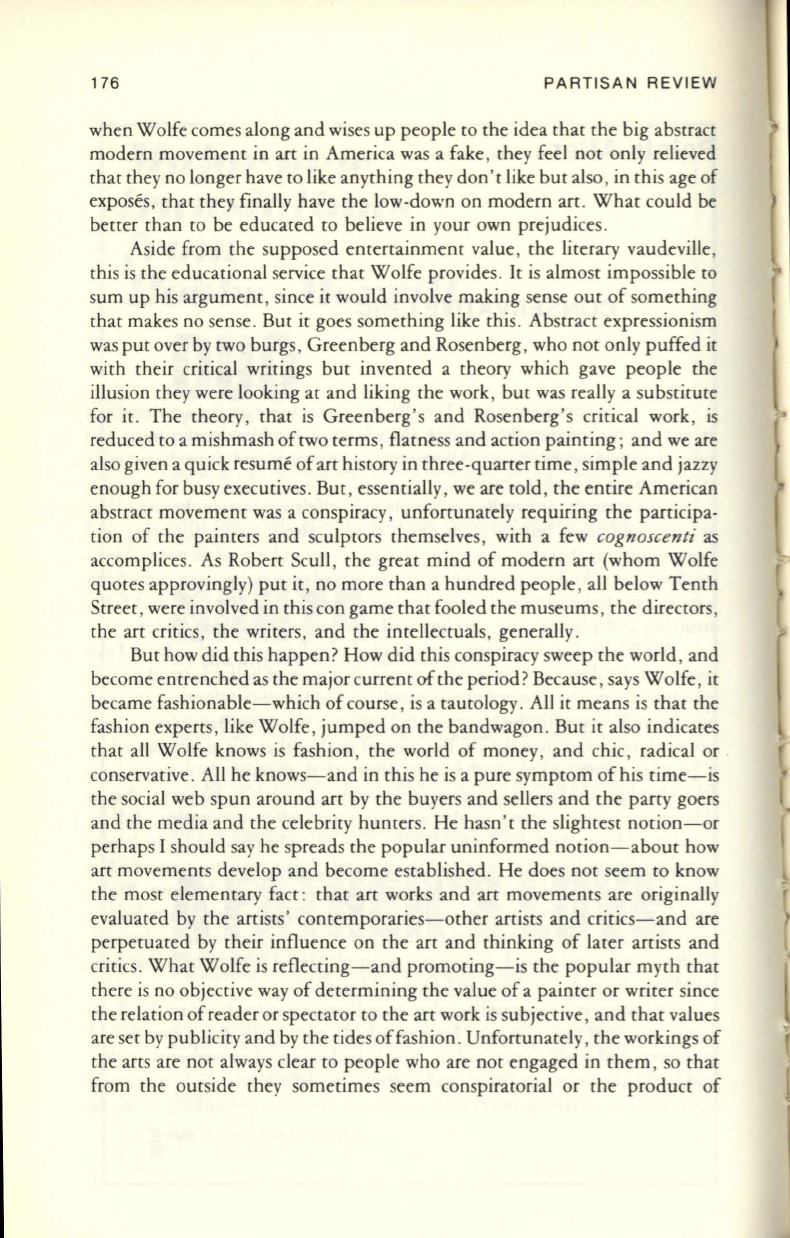
176
PARTISAN REVIEW
when Wolfe comes along and wises up people to the idea that the big abstract
modern movement in art in America was a fake, they feel not only relieved
that they no longer have to like anything they don't like but also, in this age of
exposes, that they finally have the low-down on modern art. What could be
better than to be educated to believe in your own prejudices .
Aside from the supposed entertainment value, the literary vaudeville ,
this is the educational service that Wolfe provides .
It
is almost impossible to
sum up his argument , since it would involve making sense out of something
that makes no sense. But it goes something like this. Abstract expressionism
was put over by two burgs, Greenberg and Rosenberg , who not only puffed it
with their critical writings but invented a theory which gave people the
illusion they were looking at and liking the work , but was really a substitute
for it. The theory , that is Greenberg's and Rosenberg's critical work , is
reduced to a mishmash of two terms , flatness and action painting; and we are
also given a quick resume of art history in three-quarter time, simple and jazzy
enough for busy executives . But , essentially, we are told, the entire American
abstract movement was a conspiracy, unfortunately requiring the participa–
tion of the painters and sculptors themselves, with a few
cognoscenti
as
accomplices. As Robert Scull , the great mind of modern art (whom Wolfe
quotes approvingly) put it, no more than a hundred people , all below Tenth
Street, were involved in this con game that fooled the museums, the directors,
the art critics, the writers, and the intellectuals, generally.
But how did this happen? How did this conspiracy sweep the world, and
become entrenched as the major current of the period? Because , says Wolfe, it
became fashionable-which of course , is a tautology . All it means is that the
fashion experts, like Wolfe , jumped on the bandwagon . But it also indicates
that all Wolfe knows is fashion, the world of money, and chic, radical or ·
conservative . All he knows-and in this he is a pure symptom of his time-is
the social web spun around art by the buyers and sellers and the party goers
and the media and the celebrity hunters. He hasn ' t the slightest notion-or
perhaps I should say he spreads the popular uninformed notion-about how
art movements develop and become established. He does not seem to know
the most elementary fact : that art works and art movements are originally
evaluated by the artists' contemporaries-other artists and critics-and are
perpetuated by their influence on the art and thinking of later artists and
critics. What Wolfe is reflecting-and promoting-is the popular myth that
there is no objective way of determining the value of a painter or writer since
the relation of reader or spectator to the art work is subjective, and that values
are set by publicity and by the tides offashion . Unfortunately, the workings of
the arts are not always clear to people who are not engaged in them, so that
from the outside they sometimes seem conspiratorial or the product of


